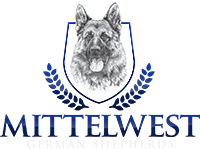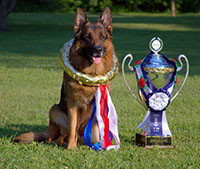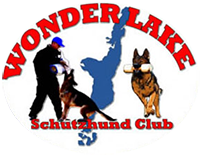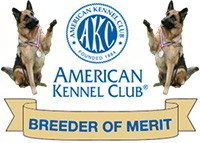TL;DR:
Training your German Shepherd starts with five basic commands: sit, stay, come, heel, and down. These build obedience, safety, and trust. Use short sessions, consistency, and rewards to achieve success.
Training builds a foundation of trust and understanding between you and your dog. It gives your German Shepherd direction, boosts their confidence, and keeps you both safe in everyday situations.
Teaching German Shepherds essential training commands helps them thrive. Known for their smarts and loyalty, these dogs need clear communication. Mastering a few basics will set them up for a lifetime of good behavior.

German Shepherd Dog Training Needs
German Shepherds are intelligent, alert, and naturally curious. Their strong work ethic motivates them to be eager to learn and grow. However, they need guidance to channel their energy in productive and controlled ways.
Without training, even the most well-meaning dog can develop troublesome habits. Early training creates boundaries and builds mutual respect. It encourages independence while preventing unwanted behaviors from taking root.
Training is about more than obedience. It’s a tool for communication that deepens your connection and sets expectations. With consistent effort, your German Shepherd can become both a companion and a teammate.
Basic GSD Training Commands That Work
Learning basic commands helps your German Shepherd understand what you want from them. These commands form the foundation for everyday interactions, making life smoother for both of you.
Every dog should grasp a core set of cues. “Sit,” “stay,” “come,” “heel,” and “down” are essential commands that promote safety, control, and positive social behavior wherever you go, together.
Mastering the following commands gives your German Shepherd structure and clarity. With repetition and positive reinforcement, your dog will begin to respond with focus and reliability. Let’s walk through them step by step.
Sit Command
Start with “sit”—the simplest yet most used command. It teaches your dog self-control and acts as a stepping stone for more complex behaviors in your training sessions.
Steps to Teach:
- Hold a treat just above your dog’s nose so they look up.
- Slowly move the treat backward over their head.
- As they lower themselves into a sitting position, say, “Sit.”
- Reward immediately when their rear touches the ground.
- Practice regularly until they sit consistently on command.
Teaching “sit” is about timing and praise. Your dog will catch on quickly with repetition. Once learned, it can help calm your dog and create polite habits in any setting.
Stay Command
“Stay” reinforces patience and helps you control your dog in exciting or potentially dangerous situations. It’s beneficial in crowded places or near distractions where stillness is essential.
Steps to Teach:
- Ask your dog to sit.
- Hold your palm out and say “stay.”
- Take one step back. If they stay, reward them.
- Increase distance gradually while maintaining control.
- If they break position, reset calmly and try again.
“Stay” is powerful once your dog understands its importance. With practice, your furry friend can hold its position even amid distractions. It builds discipline and prepares them for off-leash environments or advanced skills.
Come Command
Teaching “come” strengthens recall, which is crucial for safety. It ensures your dog returns to you quickly, whether they’re in the yard or off-leash at a park.
Steps to Teach:
- Use a long leash and let them move a few feet away.
- Crouch and enthusiastically say, “Come.”
- Gently reel them in if needed.
- Reward and praise them when they reach you.
- Practice in different settings with increasing distance.
A reliable recall could one day prevent an accident. Make “come” rewarding every time. It builds trust and makes off-leash activities more relaxed, fun, and secure for both of you.
Heel Command
“Heel” is all about walking politely without pulling on the leash. It teaches your dog to focus on you and maintain a calm pace, keeping walks stress-free for both of you.
Steps to Teach:
- Clip on a short leash and start walking.
- Say “heel” and keep your dog on one side.
- Stop when they pull. Resume once they return to your side.
- Reward frequently in the correct position.
- Gradually increase walking distance with fewer rewards.
Once your dog learns to heel, every walk becomes more enjoyable. It reduces leash tension, making neighborhood strolls or walking on busy sidewalks easier with confidence and control.
Down Command
“Down” helps create calm behavior and can be used to defuse excitement. It’s a submissive position, so teaching it builds trust and a willingness to follow your lead.
Steps to Teach:
- Begin with your dog sitting.
- Lower a treat from their nose straight to the floor.
- Slide the treat forward so they lie down.
- Say “down” as their body touches the ground.
- Offer praise and repeat until consistent.
“Down” encourages your dog to relax and settle. It’s ideal for moments when calm behavior is needed. This command also provides a solid foundation for more advanced training work.
Additional German Shepherd Training Tips
 Solid training requires more than commands—it’s also about how you teach them. Creating a consistent, positive learning environment makes your dog more eager to engage and succeed.
Solid training requires more than commands—it’s also about how you teach them. Creating a consistent, positive learning environment makes your dog more eager to engage and succeed.
- Consistency is Key: Use the same commands and gestures each time to avoid confusing your dog.
- Positive Reinforcement: Reward desired behaviors with treats, praise, or playtime.
- Short Sessions: Keep training sessions brief (5-10 minutes) to maintain your dog’s attention and engagement.
- Patience: Every dog learns at their own pace. Stay patient and encouraging.
Use short, daily sessions to keep your dog focused and engaged. Consistency across family members helps avoid confusion. Positive reinforcement, including treats, toys, or affection, strengthens the bond while motivating learning and behavior.
Training is a journey, not a one-time fix. Celebrate progress, no matter how small. As your German Shepherd learns these basics, they’ll be better prepared for future challenges and fun.
Benefits Of Basic Training Commands
Teaching your German Shepherd basic training commands does more than improve behavior—it enhances your daily life together. These commands build a safer, more responsive, and more enjoyable relationship.
Better Communication
Clear commands help your dog understand what you expect of them. They respond more quickly and with greater confidence.
- Strengthens the bond between dog and owner.
- Reduces confusion and frustration during daily interactions.
- Encourages focus and listening in different situations.
Safety & Control
Knowing commands can prevent accidents and dangerous behavior. A well-trained dog is easier to manage in unpredictable settings.
- Stops them from running into traffic or approaching strangers.
- Prevents jumping on guests or pulling on the leash.
- Gives you peace of mind in off-leash environments.
Mental & Physical Engagement
Commands give your dog something to work on, keeping their brain and body active.
- Reduces boredom-related behaviors, including chewing and barking.
- Builds routines that challenge and satisfy their instincts.
- Promotes a healthy, well-balanced lifestyle.
Basic training makes everyday life smoother. Whether you’re walking in the park or having visitors over, a well-trained German Shepherd will be more relaxed, obedient, and a pleasure to be around.
Mittelwest Provides Excellent German Shepherds
The foundation for effective German Shepherd training starts with choosing the best German Shepherd breeder. A reputable breeder can provide you with a puppy that has been socialized and exposed to basic training. Thus, it makes it easier to start teaching them at home.
When searching for the best German Shepherd breeder, prioritize those who focus on health, temperament, and early socialization. At Mittelwest German Shepherds, we consistently exceed expectations and provide a well-bred, socialized pup ready for training.
Basic training gives your German Shepherd more than good manners—it creates a foundation for a better life together. It lets your dog thrive while making your daily routine more harmonious.
With just a few simple commands and patience, you’ll see significant improvements in your dog’s behavior. And once the basics are in place, the door opens for deeper, more advanced training ahead. At Mittelwest, we provide well-trained, sociable, and well-tempered puppies.
